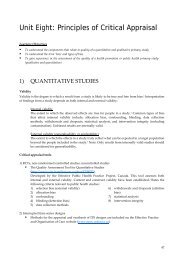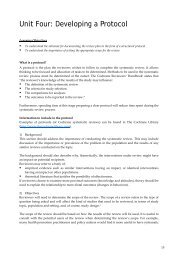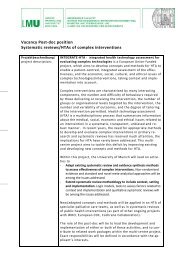Guide for Developing a Cochrane Protocol - Cochrane Public Health ...
Guide for Developing a Cochrane Protocol - Cochrane Public Health ...
Guide for Developing a Cochrane Protocol - Cochrane Public Health ...
You also want an ePaper? Increase the reach of your titles
YUMPU automatically turns print PDFs into web optimized ePapers that Google loves.
If you are including ITS studies we recommend that you assess the risk of bias of these studies<br />
using the EPOC RoB tool <strong>for</strong> ITS study designs which includes four items from the <strong>Cochrane</strong> 'Risk<br />
of bias' tool to assess per<strong>for</strong>mance, attrition, detection and reporting bias as well as the following<br />
additional items relevant <strong>for</strong> ITS studies: “was the intervention independent of other changes?”,<br />
“was the shape of the intervention effect pre-specified?” and “was the intervention unlikely to<br />
affect data collection?”.<br />
Both of the EPOC RoB tools mentioned above can be found on the EPOC website:<br />
http://epocoslo.cochrane.org/sites/epocoslo.cochrane.org/files/uploads/Suggested%20risk%20o<br />
f%20bias%20criteria%20<strong>for</strong>%20EPOC%20reviews.doc as well as guidance <strong>for</strong> how to prepare a<br />
RoB<br />
table:<br />
http://epocoslo.cochrane.org/sites/epocoslo.cochrane.org/files/uploads/How%20to%20prepare<br />
%20a%20risk%20of%20bias%20table%20<strong>for</strong>%20reviews%20that%20include%20more%20than%2<br />
0one%20study%20design.doc. Note that <strong>for</strong> some items in the RoB tool, <strong>for</strong> example blinding, it<br />
may make sense to provide a different assessment <strong>for</strong> different outcomes (<strong>for</strong> example outcome<br />
assessors may be blinded <strong>for</strong> some outcome measures and not others, or some measures may be<br />
more objective/subjective than others). Where appropriate, add additional items into the RoB<br />
table to allow <strong>for</strong> this.<br />
Alternative approaches should be discussed and agreed with your contact editor. See Appendix 3<br />
<strong>for</strong> general in<strong>for</strong>mation on Risk of bias tables (referenced from the <strong>Cochrane</strong> Handbook). This is<br />
an area of methodological development and any new tools will be available on the CPHG website.<br />
In this section you also need to describe the method by which you will summarise the risk of bias<br />
assessments. Rather than at the study level, it is recommended that you do this at the outcome<br />
level. This is due to the fact that the risk of bias may be different <strong>for</strong> different outcomes within<br />
the same study. To do this you can provide an overall risk of bias assessment <strong>for</strong> the main<br />
outcomes within each study, then provide an overall risk of bias assessment <strong>for</strong> relevant<br />
outcomes across studies, so that outcomes will be judged overall as ‘Low’, ‘Medium’ or ‘High’ risk<br />
of bias given overall considerations of the study designs, and the potential impact of the<br />
identified risks noted in the table <strong>for</strong> each study that contributed results <strong>for</strong> that outcome. Also,<br />
consider how you will address risk of bias in the synthesis of your results, considering how<br />
potential study biases might affect your conclusions.<br />
Measures of treatment effect<br />
In this section you should state how outcomes will be reported (e.g. dichotomous data) and how<br />
you will analyse and compare them (e.g. using Risk Ratios). It is likely that a number of<br />
quantitative outcome measures may be identified. You need to firstly identity the types of data<br />
you will obtain from your included study designs. For controlled studies, with continuous data,<br />
we recommend reporting means or changes in mean scores. Weighted mean difference can also<br />
be reported <strong>for</strong> continuous outcomes. Standardised mean differences should be reported when<br />
different studies use different scales to report the same outcome (e.g. quality of life scales).<br />
Where a number of outcome measures are identified, authors should use the ratio of means<br />
method (Friedrich 2008). Dichotomous (or binary) outcomes can expressed as relative risks (RR),<br />
odds ratio (OR) or risk difference (RD), however the CPHG recommends using RR (Deeks 2002).<br />
We also recommend using RR <strong>for</strong> categorical data (e.g. outcomes reported on a short Likert<br />
Last updated: 24 November 2011 - 13 -








